|
Related FAQs: Marine
Crabs 1, Marine
Crabs 2, Marine
Crabs 3, Marine
Crabs 4, By Species/Group: Arrow Crabs, Emerald Green Crabs, Decorator Crabs/Sponge Crabs,
Fiddler Crabs,
Pom Pom Crabs, Sally Lightfoots, &
FAQs on: Marine
Crab Identification, Crab Identification 1,
Crab Identification 2,
Crab ID 3, SW Crab ID 4, SW Crab ID 5, SW Crab ID 6, SW Crab ID 7, SW Crab ID 8, SW Crab ID 9, Marine Crab ID 10, Marine Crab ID 11, Marine Crab ID 12, SW Crab ID 13, SW Crab ID 14, SW Crab ID 15,
SW
Crab ID 16, SW Crab ID 17,
SW Crab ID 19,
SW Crab ID 20,
SW Crab ID 21,
SW Crab ID
22,
& Crab Behavior, Marine Crab Selection, Marine Crab Compatibility,
Marine Crab
Compatibility 2, Marine Crab Compatibility 3,
Marine Crab Systems,
Marine Crab Feeding,
Marine Crab
Reproduction, Marine
Crab Disease, Micro-Crustaceans, Amphipods, Copepods, Mysids, Hermit
Crabs, Shrimps,
Cleaner
Shrimps, Banded
Coral Shrimp,
Mantis Shrimp,
Anemone Eating Shrimp, Arrow Crabs, Emerald Green, Mithrax/Mithraculus
Crabs, Crustacean
Identification, Crustacean Selection, Crustacean Behavior, Crustacean Compatibility,
Crustacean Systems,
Crustacean Feeding,
Crustacean Disease,
Crustacean
Reproduction,
Related Articles: Hermit
Crabs, Squat
Lobsters, Crustaceans,
Fiddler
Crabs, Arrow
Crabs, Algae
Control, Nutrient Control and
Export,
/A Diversity of Aquatic Life
Crabs For Marine Aquariums?
Part 3
To:
Part 1, Part
2,
|
.JPG)
|
|
Bob Fenner
|
|
Family Mycteridae; Soldier Crabs. Look like
Spiders from afar. Walk forward/backward on their stilt-like legs, not
sideways as most crabs. Found on Asian and Australian beaches.
Family Ocypodidae; Ghost Crabs, Fiddler Crabs.
Common genera: Ocypode, Uca. Former live in moist sand, emerging
at night to feed. Ghost crabs have characteristic thickened, elevated
eyestalks. Fiddler Crab males sport an oversize claw that they use for
signaling.
| Uca crassipes (Adams & White 1848), the
Mangrove Fiddler Crab. Tropical Indo-Pacific. Males with one very
large claw. The common "Fiddler" used in the freshwater
pet trade. Can be kept with fishes, must have a place to get/dry
out. Need clean, consistent high quality water. Temp. 22-30
C. To a little over an inch in diameter. |
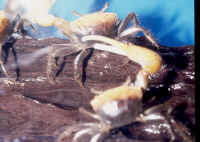
|
Family Parthenopidae: Elbow Crabs
| Lambrachaeus sp. (poss. L. ramifer);
Long-snout elbow crab. Bali 2014 |
%20BALI%20(3)%20MD.JPG)
|
Family Pilumnidae;
| Zebrida adamsii White 1847, Zebra Crab. Sea urchin
symbiont (obligate). Here in S. Leyte 2013 |
%20MD.JPG)
|
Family Pinnotheridae; Pea Crabs. Endosymbiotic
Crabs that live within Mussels, Giant Clams, Sea Cucumbers and
Tunicates/Sea Squirts. Commensals that don't feed on their
hosts (feed on detritus) but use them for protection against
predation.
Family Portunidae; the Swimming Crabs. Able to
swim, fifth pair of walking legs modified as paddles.
| Achelous sebae (H. Milne Edwards, 1834), Ocellate
Swimming Crab. Reddish brown carapace to 4" width; two eye spots on back
corners; dark claw tips. Roatan 2019 pic by LauraH. |
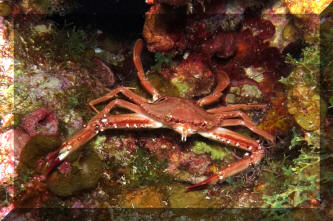
|
| Charybdis hawaiiensis Edmonson 1954, the
Hawaiian Swimming Crab. The most common large crab in HI. Striped
eyes and yellow swimming paddles on last legs are definitive. To
about three inches in carapace width. Found in Hawai'i, the
Tuamotu and Society Islands. Hawai'i pic. |
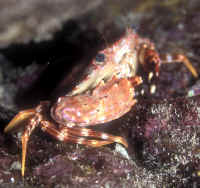
|
Bigger PIX:
The images in this table are linked
to large (desktop size) copies. Click on "framed" images
to go to the larger size. |
|
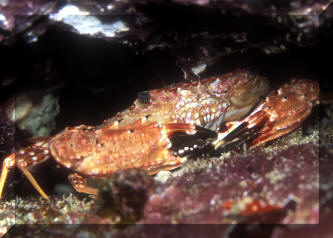
|
| Coryrhynchus sidneyi. Shortfinger Neck Crab. Triangular
body to three inches.
Trop. W. Atlantic. Shorter snout than Podochela spp. Found on gorgonians. Roatan 2019. |
%20MD.JPG)
|
| Lissocarcinus laevis Miers 1886. Gorgeously
marked with white and reddish brown. Found in association with soft
corals, anemones. Indo-Mid-Pacific; South Africa to Hawai'i. To
3 cm. Here a giant one inch one on the mud and a tiny individual on
an Alcyonacean in N. Sulawesi. Below some other N. Sulawesi
shots of the species. |
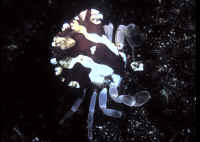 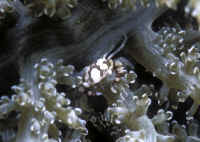
|
Bigger PIX:
The images in this table are linked
to large (desktop size) copies. Click on "framed" images
to go to the larger size. |
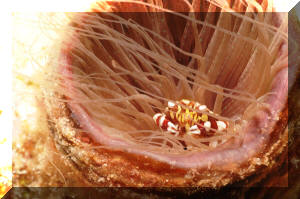
.JPG) |
| Lissocarcinus orbicularis Dana 1852. Harlequin Crab.
Variably marked, colored. Free-swimming, but usually found in association
(in or on) sea cucumbers and anemones. To about half an inch in carapace
diameter. Indo-Mid-Pacific; East Africa to Hawai'i. N. Sulawesi pix. at
right |
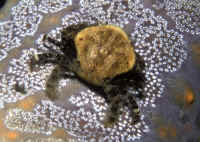 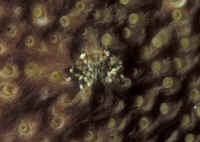
|
Bigger PIX:
The images in this table are linked
to large (desktop size) copies. Click on "framed" images
to go to the larger size. |
|
%20MD.JPG)
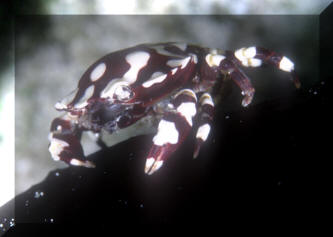
|
|
Lissocarcinus species. Here in Hawai'i
|
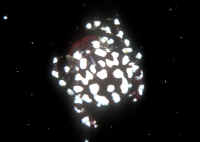 |
| Lissocarcinus species. N. Sulawesi. Here on
a sea cucumber. |
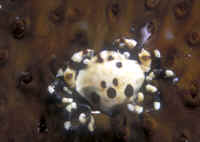
|
| Podochela species. Neck Crab. To three inches.
Trop. W. Atlantic. A decorator species that hangs out on gorgonians looking
for food in currents. Roatan pic by TiffB 2016 |
%20MD.JPG)
|
Bigger PIX:
The images in this table are linked
to large (desktop size) copies. Click on "framed" images
to go to the larger size. |
|
|
| Portunus sp. Out looking for a meal by night
in Fiji. |
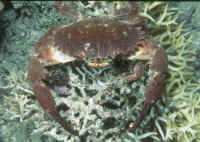
|
Family Trapeziidae; the Coral Crabs. Triangular
shaped bodies, and multi-colored chelae. Typically found in and about
corals of the genera Pocillopora and Acropora. Live well
with their own, not other crab species.
| Trapezia digitalis Latreille 1823, the Brown
Guard Crab. |
|
| Trapezia flavopunctata Eydoux & Souleyet
1842, the Yellow-Spotted Guard Crab. Similar marked to its host,
Antler Coral (Pocillopora eydouxi). To 1 inch carapace
diameter. Indo-Pacific. Hawai'i photo. |
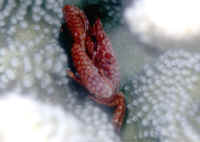
|
Bigger PIX:
The images in this table are
linked to large (desktop size) copies. Click on "framed"
images to go to the larger size. |
%20MD.JPG) |
| Trapezia tigrina Eydoux & Souleyet
1842, the Yellow-Red-Spotted Guard Crab. Similar marked to its host,
Cauliflower Coral (Pocillopora meandrina). To 1/2 inch carapace
diameter. Indo-Pacific. Fiji photo. |
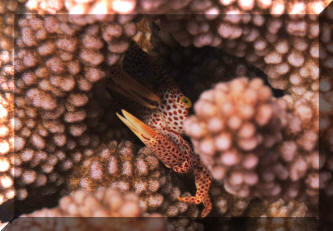
|
Bigger PIX:
The images in this table are linked
to large (desktop size) copies. Click on "framed" images
to go to the larger size. |
|
%20MD.JPG)
|
Family Xanthidae; Mud, Round Crabs, Boxing and
Pom-Pom Crabs (genus Lybia). Have round/oval carapaces, dark
tipped claws/chelae. Small, usually less than two inches
across.
| Carpilius corallinus, the Batwing Coral Crab. 3-6 in.
smooth carapace with white spots on top. Red legs with purple shading.
LeenaH pic in Key Largo 2016. |
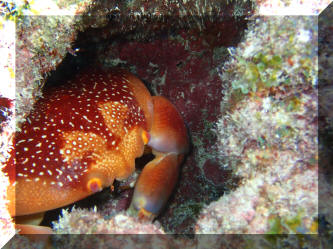
|
| Glyptoxanthus erosus, the Eroded Mud Crab. 1
1/4 to 2 in. Shell has eroded appearance. Tips of walking legs
yellow in color. Nocturnal. Picture at night off of
Cozumel. |
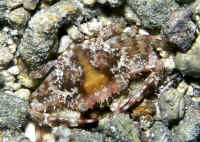
|
Genus Lybia:
| Lybia caestifera Decorator Boxer Crab. Carapace to 4
mm. Bali 2014 |
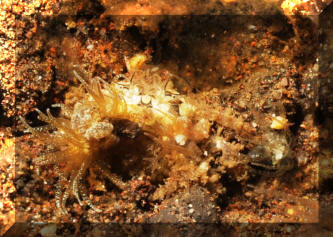
|
| Lybia tesselata (Latrelle 1812), the Pom Pom
or Boxer Crab. 1-2 cm. Carries anemones of the genus
Bunodeopsis on its claws. Indo-West Pacific; Mozambique,
Seychelles, Indonesia, PNG, Philippines. Here in N. Sulawesi. |
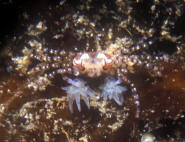
|
Bigger PIX:
The images in this table are
linked to large (desktop size) copies. Click on "framed"
images to go to the larger size. |
%20MD.jpg) |
| Platypodiella spectabilis; Gaudy Clown Crab. To 1
inch. Roatan 2016. |
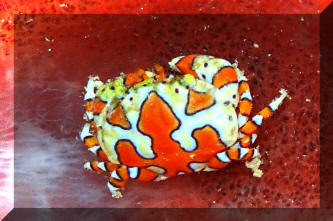
|
Unknown Crabs: Oh yes, there are
many
Bigger PIX:
The images in this table are
linked to large (desktop size) copies. Click on "framed"
images to go to the larger size. |
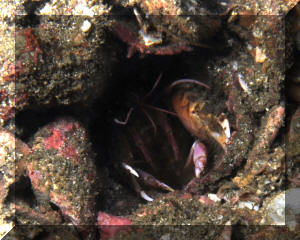 |
Bibliography/Further Reading:
Baensch, Hans & Helmut Debelius. 1994. Marine Atlas,
v.1. MERGUS, Germany. 1215pp.
Barnes, Robert. 1987. Invertebrate Zoology. Saunders.
893pp.
Baugh, Thomas M. 1991. Dwellers of the sand (Mole Crabs).
FAMA 11/91.
Bliss, Dorothy. 1982. Shrimps, Lobsters and Crabs. New
Century Press.
Chhapgar, B.F. 1988. Keep a tank in your tank. Crabs and
their cousins in the marine aquarium. FAMA 1/88.
Friese, U. Erich. 1985. Crustaceans in the home aquarium.
Crabs- hardy and long-lived, they require very little special
attention. TFH 1/85.
Headstrom, Richard. 1979. All about lobsters, crabs,
shrimps and their relatives. Dover Publ.
Johnson, Don S. 1999. Shrimp, Crabs and Lobsters in the
marine aquarium. AFM 8/99.
Kerstitch, Alex. 1992. Crabs in the aquarium. From
Fiddlers to Pom-Poms. FAMA 2/92.
Lau, Collin J. 1986. The A-peeling Box Crab. FAMA
8/86.
Shimek, Ronald L. 1998. Crabby comments. Give proper
conditions, crabs make happy, enjoyable and entertaining pets. AFM
2/98.
Sticker, Walter T. 1982. Keeping tabs on Crabs, pts.
I,II. FAMA 7,8/82.
Tullock, John H. 1999. Crabs and their relatives. AFM
3/99.
Volkart, Bill 1989. Colorful Crustaceans: an
introduction to Crabs. TFH 7/89.
Walls, Jerry G. 1995. Crab watch: the Japanese Shore
Crab, Hemigrapsus sanguineus. TFH 3/95.
Arrow Crabs:
Giwojna, Pete. 1987. Arrow Crabs. Housebreaking the narrow-snout
bristle horn, pts. I, II, III. FAMA 5,6,7/87.
Giwojna, Pete. 1991. The acrobatic sex life of the Arrow Crab. FAMA
9/91.
Fiddler Crabs:
Mancini, Alessandro. 1992. Fiddling with Fiddler Crabs. TFH
10/92.
Wickstein, Mary K. 1977. Fun with Fiddlers. TFH 12/77.
To:
Part
1, Part
2,
 |
New Print and
eBook on Amazon
Marine Aquarium Algae Control
by Robert (Bob) Fenner
|

